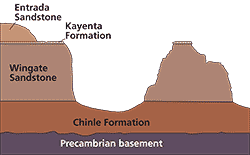 |
| Generalized rock chart for Colorado National Monument. The Wanakah Formation, a thin layer below the Entrada Sandstone, and the layers above the Entrada are not shown. |
Colorado National Monument near Grand Junction isn’t as well-known as most of Utah’s national parks and monument. It is a small site (only about 20,500 acres) that is about 25% of the size of Arches National Park. The monument doesn’t receive the heavy visitation that Arches and Canyonlands do, and it has the feel of a regional park that is more often frequented by families than an international destination like the parks near Moab.
Nonetheless, the area has been a national monument for more than 90 years, being established before most of the iconic national park sites on the Colorado Plateau such as Grand Canyon, Canyonlands, and Capitol Reef. The monument is a great place to hike, sightsee, and drive or bike along the 23-mile Rim Rock Drive, which is listed on National Register of Historic Places.
Colorado National Monument also serves as a great introduction to the geology of the region, sharing several important features in common with its more famous neighbors. It contains exposures of the Great Unconformity similar to the ones in Grand Canyon. Colorado National Monument has been uplifted along a monocline, akin to the one in Capitol Reef National Park. The monument contains miles of red sandstone cliffs à la Canyonlands. It also contains the beautiful Entrada Sandstone like in Arches National Park, and the Morrison Formation with its incredibly important fossil record similar to those found in Dinosaur National Monument. In sum, Colorado National Monument can be described as having portions of many of the outstanding geological attributes that make the Colorado Plateau the greatest show of Earth.
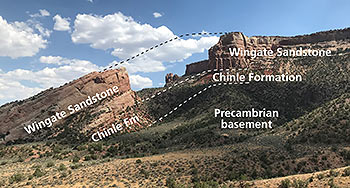 |
| The monocline at Colorado National Monument is evident from the tilt of the Wingate Sandstone (left) to where it has been uplifted on the right and is nearly horizontal. |
Most of the rocks exposed in Colorado National Monument are the same ones as those that make up the bulk of the scenery near Moab. The most prominent rock layers (formations to geologists) in the monument are the Wingate Sandstone and the Kayenta Formation. As they both are mostly sandstone, they are resistant to erosion, and hold up the cliffs that make up most of the monument’s soaring cliffs similar to those in Canyonlands. As also in Canyonlands, a softer layer (the Chinle Formation) that is predominantly made of mudstone is found directly beneath the Wingate. The soft Chinle forms slopes, but the layer is largely obscured by boulders and other rockfall debris derived from the overlying sandstones.
But, underneath the Chinle Formation, the geology of Colorado National Monument is dramatically different than that in Canyonlands. The Chinle doesn’t sit on top of the Moenkopi Formation like in Canyonlands, but instead overlies a much, much older set of crystalline rocks. These rocks are part of the ancient core of the continent widely known the Precambrian basement.
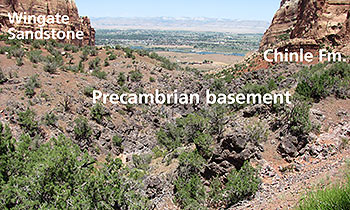 |
| The Great Unconformity in Fruita Canyon near the West Entrance of Colorado National Monument. The Chinle Formation is much less resistant to erosion than the underlying Precambrian basement, making the unconformity itself relatively poorly exposed. |
A gap in the rock record such as this is known as an unconformity. In Colorado National Monument, the approximately 220-million-year-old Chinle Formation directly overlies the 1,720 million-year-old-Precambrian basement. Unconformities can be of any length of time, from a short million years or less to massive expanses in which one third of Earth’s history is missing between the Chinle and the Precambrian basement in Colorado National Monument.
In the Southwest, the unconformity on top of the Precambrian basement was named the Great Unconformity by geologist John Wesley Powell at Grand Canyon where the sedimentary Tapeats Sandstone lies directly on top of the Precambrian basement of the Granite Gorge. In some ways, the Great Unconformity in Colorado National Monument is more impressive than that in Grand Canyon because it spans an even greater expanse of time—1.5 billion years versus only 1.2 billion in Grand Canyon!
The Chinle Formation sits on top of the Precambrian basement in Colorado National Monument because it is located at the north end of the Uncompahgre uplift, an area that has undergone repeated periods of mountain-building throughout geologic time. The Uncompahgre was uplifted and subjected to erosion about 300 million years ago when the Ancestral Rocky Mountains were formed, and again more recently during a broad mountain-building event known as the Laramide Orogeny during the last 70 million years or so. On the Colorado Plateau, areas of steeply dipping rocks (monoclines) formed during the Laramide. Monoclines can be thought of half of a geologic fold where one area has been uplifted relative to that on the other side. The monocline (and associated geologic faults) on the northeast side of Colorado National Monument accommodated the uplift of Colorado National Monument relative to Grand Valley.
Although Colorado National Monument shares some geologic features and overall geologic history with other landscapes found in the desert southwest, it is a unique geologic tableau. Its exposed rock layers, geologic structures like its monocline, and the Great Unconformity come together along the north end of the Uncompahgre uplift to form a compelling geologic story and spectacular scenery viewable from the Rim Rock Drive.
Colorado National Monument is located about 100 miles northeast of Moab. To learn more, please visit
https://www.nps.gov/colm/index.htm.
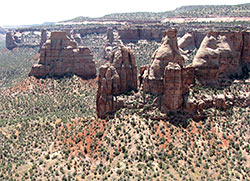 |
|
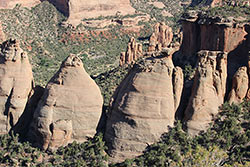 |
| Spires and monoliths of the Wingate Sandstone with a thin cap of the Kayenta Formation in Monument Canyon. |
|
The Coke Ovens rock features are made of the Wingate Sandstone with just small remnants of the more resistant Kayenta Formation at the very tops. |
|